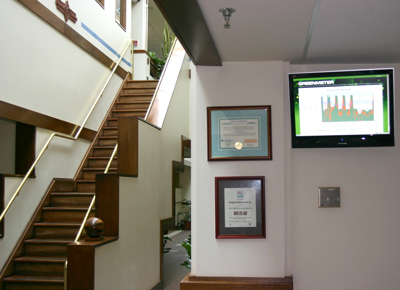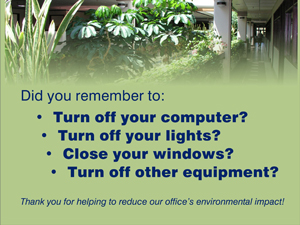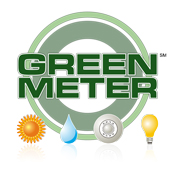Ecology and Environment Sets the Sustainability Bar Even Higher in Achieving an 80-Percent Carbon Reduction at Net Cost Savings.
"Ecology and Environment" Achieves an 80-Percent Carbon Reduction at Net Cost Savings
Gerard A. Gallagher III | Ecology and Environment Inc.
Ecology and Environment, Inc., (NASDAQ: EEI) has been a quiet leader in “walking the sustainability walk” since its inception in 1970. Its practices in energy and water conservation, recycling and composting, and the use of recycled, non-polluting and energy-efficient products extend back to a time when “green” was not widely embraced, but was something E & E’s founders held a personal belief in employing throughout the company’s business practices.
“From our use of 100-percent recycled paper products since 1971, to our proactive yearly report on internal sustainability activities since 2004, at E & E we believe environmental responsibility is not a new way of doing business – it’s the only way of doing business,” said E & E president and CEO Kevin Neumaier.
The environmental consulting firm’s recent announcement of achieving an 80-percent reduction in annual carbon emissions associated with building energy use at its global headquarters in Lancaster, N.Y., thus comes as little surprise. E & E’s achievement––accomplished in just nine years––is the result of a series of measures, targeted toward not only infrastructure improvements but the direct engagement of employees in energy efficiency, that have also netted hundreds of thousands of dollars in savings.
“Climate change experts have been debating the crucial need for carbon footprint reduction over the past 25 years, and are recommending an 83-percent reduction in global greenhouse gas emissions by 2050,” Neumaier said. “Based on our experience this goal is not only achievable, but if done right will foster an actual economic gain. Without enough data and real world examples, some fear that greenhouse gas reduction initiatives will cripple the world economy. E & E’s experience over the past nine years is that there is a path to meeting global targets, and it provides great ROI.”
Efforts implemented between the baseline year of 1999 and 2008 specifically enabled the company to achieve a37 percent (12,000-ccf) reduction in natural gas usage and 23 percent (198,000-kWh) reduction in electricity usage. Furthermore, comparing associated upfront costs of approximately $58,000 for energy conservation measures plus $20,000 for the purchase of Renewable Energy Credits (low-impact wind and hydro power) with an estimated $310,000 in energy cost savings from 1999 to 2008, the company saved approximately $232,000 over the nine-year period. Based on current energy costs, E & E additionally estimates annual savings of $43,000 relative to energy costs that would have been accrued prior to implementing its energy conservation measures.
E & E employed a variety of GHG reduction methods that contributed to this achievement, including the development of GreenMeter® (greenmeter.com), a “real-time” energy consumption tracking and management system designed to identify energy efficiency opportunities. In addition to developing the system, E & E installed a GreenMeter monitor in the lobby of its headquarters, allowing both employees and visitors to readily viewbuilding energy use data throughout the day.

“Actively engaging our employees in this effort was critical to our success,” said Neumaier. “We did everything from post reminders about turning off unnecessary lighting and equipment, to implement an energy efficiency program that showed documented results, through GreenMeter, of how their conservation efforts were making a real and direct impact. This not only kept the momentum going, it contributed to a long-term behavioral and cultural shift among our employees. Our experience suggests that organizations the world over stand to gain as we have when they address not only the technical operations of their building, but the involvement of their most important asset—their people.”

Combined with behavioral changes, other energy conservation efforts included replacement of all incandescent lighting with fluorescent lighting (CFLs and low-mercury T8 lamping) and purchasing ENERGY STAR®-rated kitchen and office equipment. E & E also retrofitted air-handling unit fans with variable-speed drives (VSDs), installed a BuildingAutomation System (BAS) with direct digital controls (DDC), optimized air handling unit (AHU) scheduling by matching run times to building occupancy requirements, and optimized natural air circulation through a company-wide e-mail notification system for opening and closing windows.
According to Neumaier, the cost savings associated with these efforts should not be ignored: “Our experience in fostering sustainable development across the globe belies the economic crisis some predict greenhouse gas reduction efforts will create,” he said. “Like the thousands of worldwide project we’re working on, we are committed to reducing any negative environmental impact associated with the operation of our headquarters, and have found that focusing on sustainability is not only good environmentally, but also economically.”
Built in 1986, E & E’s 64,000-square-foot headquarters building is also the world’s oldest LEED® Platinum-certified structure under the U.S. Green Building Council’s LEED for Existing Buildings (LEED-EB) rating system. Thus, the company’s 80-percent GHG reduction accomplishment is magnified by the fact that it began focused energy efficiency efforts in 1999 with a building already achieving better-than-average energy efficiency.
“This is not only a testament to the fact that others can most certainly follow our lead, but that further efforts can be made within even today’s ‘greenest’ buildings,” Neumaier said.
With its headquarters building and as a company overall, E & E continues to model that “green” is not only possible, it can also be prosperous. Recently recognized as one of 2009’s “FSB 100” Top 100 Fastest-Growing Companies by Fortune Small Business, E & E has also experienced significant gains as the world market continues to accelerate its sustainability practices.
“In 2008, during one of the bleakest years in the stock market’s history, we managed to achieve a 40-percent earnings increase in the fourth quarter,” Neumaier stated. “This speaks loud and clear to the way the green economy is flourishing, and the role we continue to play within it.”
To learn more about E & E’s sustainability initiatives, visit www.ene.com and download the company’s recently published 2008 corporate sustainability report.
 Ecology and Environment, Inc. Headquarters
Ecology and Environment, Inc. Headquarters368 Pleasant View Drive
Lancaster, NY 14086
Quick Facts:
-
Built in 1988
-
Awarded LEED-EB Platinum in 2008
-
300-foot-long atrium
-
More than 1,000 indoor plants
-
Rooftop solar panels
-
Functions on 100% renewable electricity
-
HQ property is a 100 acre nature preserve
-
160 bird species on property
-
Member of Great Lakes Marsh Monitoring Program
Building at a Glance:
Name: Corporate Headquarters
Location: 368 Pleasant View Drive, Lancaster, NY
Owner: Ecology & Environment, Inc.
Principal Use: Office
-
Includes: Private offices, open work stations, Lobby, full length Atrium, Training Area, Multi-purpose Room, several Conference Rooms, 2 kitchenettes, maintenance areas, Operations Center, Computer Center, Copy Center.
Employees/Occupants: 230 +/- (varies)
Gross Square Footage: 65,600 SF
-
Cost Per Square Foot: $95
Substantial Completion/Occupancy: 1988
Occupancy: 100%
Distinctions/Awards: E&E Headquarters facility is the oldest building in the world to be awarded the Platinum rating under LEED for Existing Buildings—only the tenth nationwide and the first in New York State.
Energy at a Glance:
Energy Use Intensity (Site)3 (2008): 70 kBtu/ft2
Renewable Energy6: No annual intensity available yet. In 2009, E&E began operation of its 22 kW (kilowatt) system, estimated to produce approx 25,000 kWh (kilowatt hours) of electricity annually, replacing 1.3 kBtu/ft2of grid-supplied electric energy.
Annual Source Energy7 (2008): 128 kBtu/ft2
Annual Energy Cost Index (ECI): 8 2008: 1.89 $/ft2 · yr for energy, does not include an additional 0.11 $/ft2 · yr for Wind energy credits.
Savings vs. Standard 90.1-2004 Design Building:9 %
ENERGY STAR Rank10:
Key Sustainable Features11:
Water Conservation: In 2008, our headquarters facility used 501,000 gallons of water. This is 16,000 fewer gallons than we used in 2007, and 234,000 gallons fewer than in 2006. We achieved these reductions by replacing older toilets and using dual-flush valves, such that they now use only 1.1 or 1.6 gallons per flush.
Indoor Environmental Quality: In 2008, we continued to prioritize the use of recycled, nonpollutive and energy efficient material from floor to ceiling. This companywide standard requires the use of Interface™ carpet tiles, low-volatile organic compound (VOC) paints, ENERGY STAR appliances, compact fluorescent light bulb (CFL) or light emitting diode (LED) bulbs, and ceiling tile with high recycled connect. We have eliminated smoking indoors and outdoors on our premises, and we ensure that our building maintenance staff uses nontoxic cleaning chemicals unless absolutely necessary. We utilize Green Seal™-approved cleaning products at our headquarters.
Material Waste: We continue to use 100% recycled paper, as we have done since 1971, for our reports and printed documents. We use nonbleached paper towels, biodegradable trash bags, and 100% biodegradable disposable utensils in our cafeteria as part of our composting and recycling program to minimize waste.
Recycling: In 2008, approximately 27 tons of paper and 3.85 tons of “co-mingles” (i.e., mixed glass, aluminum, and plastic). Approximately 8.25 cubic yards of compost were generated.
Daylighting: We maintain natural airflow throughout the building during all temperate weather months via operable windows and ceiling louvers built into our 300-foot-long atrium.
Energy Use: Building on next-generation meters, we continued to develop and refine GreenMeter, a dynamic energy tracking and management system designed for schools, businesses, universities and commercial buildings. We continue our voluntary participation in a Demand Response Program to limit the potential for brownouts or blackouts in our community when electricity demand peaks.
Solar Panels: Installation December 2008, System Size 96 panels x 230 watts each = 22 kW total. The system produces ~25,000 kWh of electricity annually.
Building Team12:
Building Owner/Representative: Ecology & Environment, Inc
Architect: Canon
General Contractor: Concept Construction
Mechanical Engineer: Canon
Electrical Engineer: Canon
Energy Modeler: Canon
Structural Engineer: Canon
Civil Engineer: Canon
Environmental Consultant: Canon/E&E
Landscape Architect: Canon
Lighting Design: Canon
LEED Consultant: N/A
1 Optional: Use only if it provides insight into energy consumption
2 This is the cost of the new building or the renovation project. For new projects, do not include property cost or site work.
3 Includes gas plus electricity, other and on-site renewable energy. Exclude any renewable energy that is exported.
4 Multiply kWh by 3.412 to get KBtu
5 Includes steam, fuel oil, district cooling and other sources
6 This is renewable energy generated on-site
7 Sum of DOE source-site ratio of non-renewable energy consumed per year. Use attached worksheet
8 If available. Includes only purchased energy (gas+electricity+other)
9 If available.
10 Use only when available
11 Include major features
12 Use only appropriate positions
Gerard A. Gallagher III
Senior Vice President for Environmental Sustainability
Mr. Gallagher’s 29-year background with E & E includes the direction of numerous complex environmental investigations and remedial programs for government agencies and the private sector. He has been the senior vice president in charge of environmental sustainability since August 2008, was the South East Regional Manager from 1999 to 2008, and also managed E & E’s Tallahassee office for the preceding 10 years.
Senior Vice President for Environmental Sustainability
Mr. Gallagher’s 29-year background with E & E includes the direction of numerous complex environmental investigations and remedial programs for government agencies and the private sector. He has been the senior vice president in charge of environmental sustainability since August 2008, was the South East Regional Manager from 1999 to 2008, and also managed E & E’s Tallahassee office for the preceding 10 years.
About E & E
Headquartered in Lancaster, N.Y., Ecology and Environment, Inc. has completed more than 45,000 projects for a wide variety of clients in 84 countries, providing environmental solutions in nearly every ecosystem on our planet. The company is listed on the NASDAQ under the symbol EEI and is located on the web at www.ene.com.
The content & opinions in this article are the author’s and do not necessarily represent the views of AltEnergyMag
Comments (0)
This post does not have any comments. Be the first to leave a comment below.
Featured Product

HPS EnduraCoilTM Cast Resin Medium Voltage Transformer
HPS EnduraCoil is a high-performance cast resin transformer designed for many demanding and diverse applications while minimizing both installation and maintenance costs. Coils are formed with mineral-filled epoxy, reinforced with fiberglass and cast to provide complete void-free resin impregnation throughout the entire insulation system. HPS EnduraCoil complies with the new NRCan 2019 and DOE 2016 efficiency regulations and is approved by both UL and CSA standards. It is also seismic qualified per IBC 2012/ASCE 7-10/CBC 2013. Cast resin transformers are self-extinguishing in the unlikely event of fire, environmentally friendly and offer greater resistance to short circuits. HPS also offers wide range of accessories for transformer protection and monitoring requirements.
